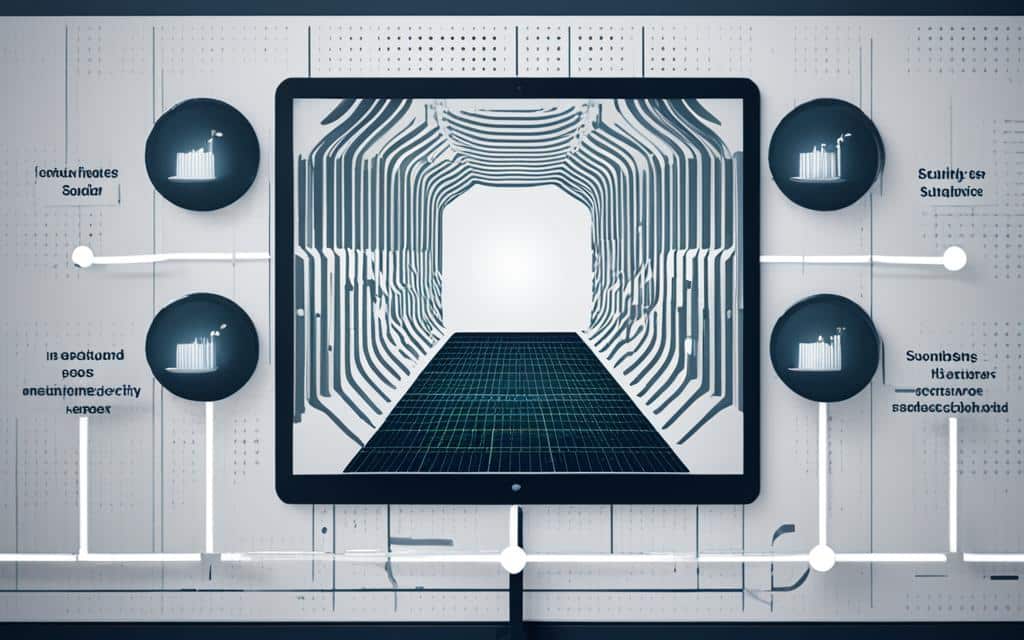Table of Contents
Sound design is a crucial element in interactive media, playing a significant role in enhancing user engagement and experience. With the evolution of technology, sound design has undergone a transformation, combining traditional techniques with cutting-edge advancements to create immersive and realistic soundscapes.
Examples such as “Black Panther” and “Blade Runner 2049” showcase how sound design can elevate the viewer’s experience, creating mood, atmosphere, conveying emotion, and highlighting key moments. This integration of sound and visual elements enhances the overall user experience, making interactive media more captivating and memorable.
The future of sound design is promising, with advancements in AI, machine learning, virtual and augmented reality, and sound mixing and mastering. These innovations open up new possibilities for creating dynamic and immersive audio experiences. By embracing these technologies, sound designers can craft rich and captivating soundscapes that draw viewers deeper into the interactive media.
Good sound design in interactive media creates an emotional connection with the audience, maintaining their attention, and increasing overall satisfaction. It establishes a consistent tone and style, enhancing the storytelling and enabling viewers to fully immerse themselves in the experience.
In conclusion, sound design is a critical component of interactive media, with the potential to significantly impact user engagement and experience. As technology continues to evolve, the future of sound design holds exciting possibilities, promising even more innovative and immersive audio experiences for viewers.
The Evolution of Sound Design in Interactive Media
Technological advancements have revolutionized sound design in recent years, allowing for a blend of traditional techniques and cutting-edge technology. This combination has resulted in the creation of immersive and realistic soundscapes that enhance the viewer’s experience in interactive media.
The use of advanced algorithms and specialized speaker systems like Dolby Atmos has contributed to the trend of immersive sound, providing a three-dimensional audio experience. These advanced algorithms analyze audio data to optimize sound placement and movement, creating a more lifelike and enveloping audio environment.
In addition to immersive sound, the integration of AI and machine learning for audio has brought further enhancements to sound design. AI algorithms can now analyze audio content to suggest appropriate sound effects and music, significantly speeding up the sound design process and reducing resource requirements. This allows sound designers to focus more on the creative aspects and refine the overall audio experience.
Immersive sound and advanced algorithms have transformed the way interactive media engages its audience. Whether it’s a video game, virtual reality experience, or interactive website, sound design has the power to transport users into a new world, creating a more immersive and engaging experience.
“The use of advanced algorithms and immersive sound technologies has enabled us to create soundscapes that were previously unimaginable. It’s an exciting time for sound design in interactive media.” – John Williams, Sound Designer
With the continuous evolution of technology, the future of sound design in interactive media holds even more possibilities. Advancements in virtual and augmented reality, haptic feedback, and spatial audio technology will further enhance the immersive experience, making it more realistic and interactive for the user.
| Technological Advancements | Impact on Sound Design |
|---|---|
| Advanced algorithms | Optimized sound placement and movement, immersive sound experience |
| Specialized speaker systems | Enhanced spatial audio, three-dimensional sound |
| AI and machine learning | Automated sound analysis, suggestion of sound effects and music |
The Role of Sound Design in Motion Design
Sound design plays a vital role in motion design, often overlooked but crucial for creating an immersive experience and a professional final product. It goes beyond the visual elements, enhancing the emotional impact and establishing a consistent tone and style throughout the project. By incorporating different types of sound design, such as music, sound effects, and spoken word, motion designers can evoke specific emotions and create a more immersive experience for the viewer.
Good sound design creates atmosphere and supports the story, effectively conveying the intended message to the audience. It enhances engagement, maintaining the viewer’s attention and making the project more enjoyable to watch. Whether it’s a film, a marketing video, or an interactive presentation, sound design adds depth and professionalism, elevating the overall quality of the final product.
Music in Motion Design
The choice of music in motion design is crucial for setting the right mood and enhancing the viewer’s emotional connection to the visuals. Well-selected music can evoke specific emotions, create tension, build excitement, or convey a sense of calm. From catchy tunes to atmospheric compositions, the right music enhances the storytelling and adds a layer of depth to the motion design project.
Sound Effects in Motion Design
Sound effects are indispensable in motion design, as they help punctuate key moments, emphasize visual transitions, and draw attention to important details. Whether it’s a swoosh, a beep, or a crash, sound effects add impact and contribute to the overall immersion of the viewer. Well-designed sound effects can make the visuals more dynamic and engaging, elevating the overall viewing experience.
Spoken Word in Motion Design
Incorporating spoken word elements, such as voiceovers and narration, can bring a human touch to motion design projects. Voiceovers provide additional context, convey information, or guide the viewer through the visual content. Narration can add depth and story-driven elements to the motion design, helping to tell a compelling narrative. Carefully choosing the right voice and delivering well-crafted scripts can create a powerful impact, making the motion design project more memorable and immersive.
By giving equal attention to sound design alongside visual design in motion projects, motion designers can create an immersive and professional final product that captivates the audience and leaves a lasting impression. The combination of visuals and well-crafted sound design ensures a cohesive and impactful motion design experience.
Exploring Sound Design in Interactive Media: Music, Sound Effects, and Spoken Word
Sound design plays a pivotal role in creating immersive and engaging interactive media experiences. It encompasses various elements, including music, sound effects, and spoken word. Each of these elements contributes to the overall immersive experience, enhancing user engagement and bringing interactive media projects to life.
1. Music: Music is a powerful tool in interactive media, capable of evoking emotions, setting the mood, and enhancing storytelling. From stock audio files to customized compositions, the choice of music can greatly impact the viewer’s experience. By carefully selecting music that aligns with the project’s objectives and target audience, sound designers can create a seamless and captivating interactive media experience.
2. Sound Effects: Sound effects serve as essential elements in interactive media, enhancing key moments, punctuating actions, and creating a sense of realism. From the subtle rustling of leaves to the explosive crash of thunder, well-crafted sound effects add depth and dimension to the interactive experience. Sound designers can source these effects from dedicated vendors or create custom sounds to suit the project’s specific needs, ensuring a cohesive and engaging auditory experience.
3. Spoken Word: Incorporating spoken word elements in interactive media adds a human touch, conveying information, and enriching storytelling. Voiceovers, narrations, and previously recorded materials provide a compelling narrative that complements the visual components, enhancing the viewer’s understanding and emotional connection. By carefully selecting the right voice talent and recording techniques, sound designers can create a seamless integration of spoken word, delivering a polished and professional final product.
Sound design in interactive media, with its integration of music, sound effects, and spoken word, amplifies the user’s experience, immersing them in a world that engages their senses. By carefully considering each element and its purpose, sound designers bring the interactive media to life, creating a memorable and captivating journey for the viewer.
“Sound design allows us to widen the spectrum of perception, to individuate and differentiate, and to bring emotional impact to the narrative.”
Sue Pelino
Conclusion
Sound design plays a critical role in the filmmaking and interactive media process. Advancements in technology have led to the evolution of sound design, transforming it into a key component for creating immersive and engaging experiences for viewers. The importance of sound design in the overall cinematic or interactive media experience cannot be overstated.
Whether it’s in movies or interactive projects, sound design has the power to elevate the viewer’s experience, making it more memorable and impactful. By creating mood, atmosphere, and conveying emotions, sound design enhances the storytelling and keeps the audience engaged throughout. Its ability to highlight key moments and support the visual elements truly enhances the viewer experience.
As technology continues to advance, the future of sound design looks promising. With innovative techniques and immersive audio experiences, interactive media will continue to captivate audiences on a whole new level. The importance of sound design in creating an unforgettable viewer experience cannot be underestimated.
FAQ
What is the role of sound design in interactive media?
Sound design plays a vital role in interactive media, enhancing user engagement and experience. It creates mood, atmosphere, conveys emotion, and highlights key moments, ultimately enhancing the viewer’s experience.
How has technology revolutionized sound design in interactive media?
Technological advancements have revolutionized sound design, allowing for a blend of traditional techniques and cutting-edge technology. Advanced algorithms, specialized speaker systems like Dolby Atmos, and the integration of AI and machine learning have contributed to the creation of immersive and realistic soundscapes.
Why is sound design important in motion design?
Sound design is crucial in motion design as it enhances the emotional impact of visual elements, establishes a consistent tone and style, creates atmosphere, supports the story, and enhances engagement, making the project more enjoyable to watch.
What elements make up sound design in interactive media?
Sound design in interactive media encompasses various elements, including music, sound effects, and spoken word. Each type of sound design serves a specific purpose and contributes to the overall immersive experience in interactive media projects.
What is the future of sound design in interactive media?
As technology continues to advance, the future of sound design holds exciting possibilities for even more innovative and immersive audio experiences in interactive media. The advancements in AI, machine learning, and virtual and augmented reality present promising opportunities for the field.









